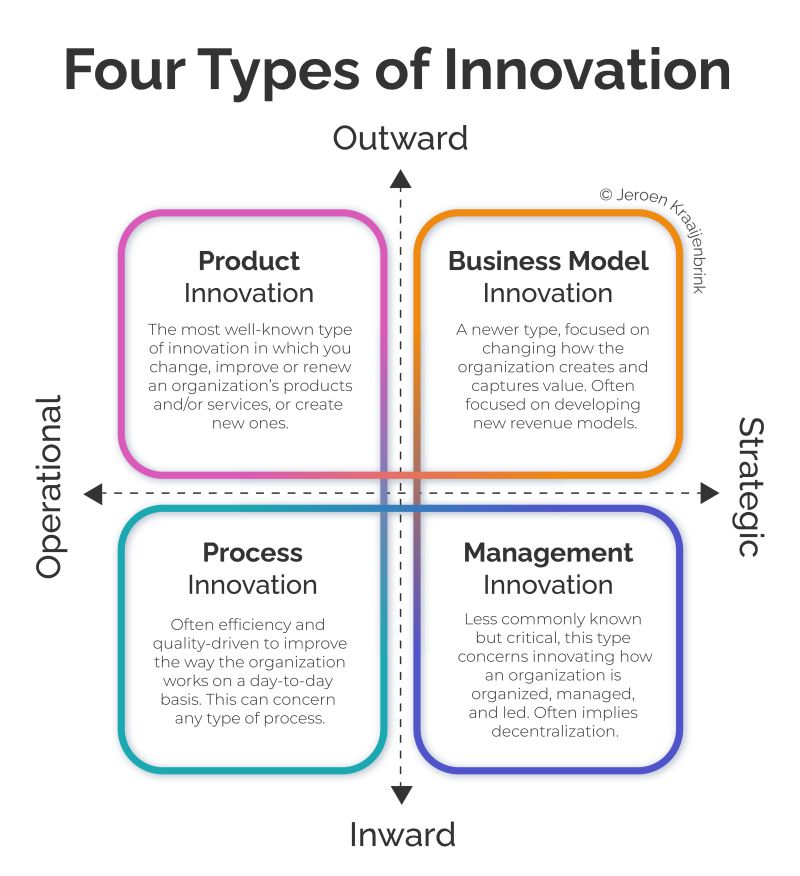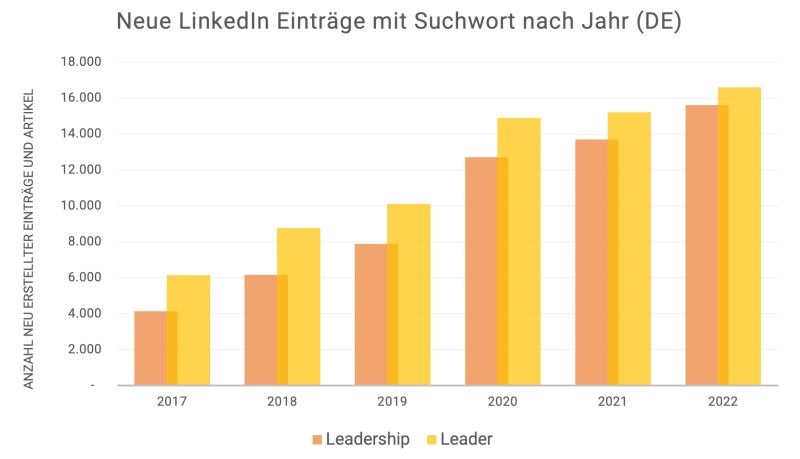Impulses for organisations – Part 4
As a social media user, I come across numerous impulses from experts who address different topics within organisations or discuss aspects of the work. I would like to put individual impulses “in the shop window” here on the t2informatik Blog again. This time it’s about innovation, the desire for leadership and the effect of bonuses.
Here we go with the impulses!
Four types of innovation
Every organization needs to innovate. But what type of innovation to give priority to? This simple matrix with four types of innovation may help.
Innovation basically means introducing something new (‘nova’). This “something new” can be anything and that’s where the problem starts. In two ways.
- First, by an overemphasis on product (or service) innovation, thereby not giving enough attention to other types.
- Second, by getting overwhelmed by all the innovation opportunities that are out there.
To solve both problems at the same time, it helps to gain some clarity on what types of innovation there are. To that end, I’ve created this simple 2×2 matrix containing what I think are the four most important types of innovation for every organization.
Let me first explain the two axes:
The first is the inward-outward axis. Outward-oriented innovations are those innovations that are mostly targeted at the market, at doing something new for customers. Inward-oriented innovations, on the other hand, are innovating the organization itself.
On the second axis, Operational innovations are typically quite technical and tangible, and focused on the practical work and output. Strategic innovations, on the other hand, regard how the organization is functioning overall and how it creates value.
This leads to the following four types of innovation:
- Product Innovation. The most well-known type of innovation in which you change, improve or renew an organization’s products and/or services, or create new ones.
- Process Innovation. Often efficiency and quality-driven to improve the way the organization works on a day-to-day basis. This can concern any type of process.
- Business Model Innovation. A newer type, focused on changing how the organization creates and captures value. Often focused on developing new revenue models.
- Management Innovation. Less commonly known but critical, this type concerns innovating how an organization is organized, managed, and led. Often implies decentralization.
All four types are important and with this matrix you can start managing your innovation portfolio. Ask yourself questions like: Do I have sufficient initiatives in all quadrants? And, which type of innovation should get priority now?
The longing for leadership
Your longing for good leaders misses the point!
For me, the never-ending hype about #leadership and #leaders is an expression of a tragic longing.
- People want to be treated like people, not like machines.
- They want to treat other people like people, not like machines.
- People want to perform for each other and do meaningful work that gives them resonance, connection and control.
Don’t they? Well, that’s gratifying!
And then we come to a momentous misconception: We overlook the fact that it is not individual special heroes (leaders) that are the prerequisite for human, lively togetherness, but systems and their structures. We cry out for good leaders and overlook the fact that “leaders” come from the same system from which our longing is to escape. We distinguish between leaders and managers and ignore that both “personifications” are at home in the system of #management.
A leader, even a really good one, does not overcome system management.
Your longing is misplaced with the supposed leaders of this world.
The alternative is to replace system management – central control – command & control – top-down & bottom-up – with a system that allows thinking and acting to belong together instead of separating them, that does not categorise into “above” and “below”, leaders and followers, but that allows for the complexity and liveliness of the social phenomenon “leadership”. A system that promotes performance for others instead of strengthening positions and bureaucracy.
Only a different system of performance can satisfy your longing!
That this is not a utopia is shown by numerous organisations that are consistently decentralised and give leaders the power to shape and decide that they deserve.
Do not look for leaders! Create other organisations or join decentralised organisations. The theory, principles and practices are already there.
Are you longing for human interaction? Then look at the structures that make it difficult. Redesign structures – on a small scale and on a very large scale.
Are you wondering how? Very good! This is the beginning of a wonderful development.
Kill the carrot
Want to quickly improve culture and lighten the load? Kill the carrot.
I worked in a consultancy with a high bonus and in a team with team goals. Guess where I was better off and where we were more motivated to work together to delight our clients?
Individual targets and bonuses are still widespread in performance management. Often the alternative may be missing, but it also shows me that HR too often lags behind the evidence. Follow scholars like Antoinette Weibel and you know: Bonus eats culture for breakfast.
7 points on the undesirable consequences of bonuses:
1. competition and silo thinking. More money for high performers! Disadvantage: Why should I – thinking rationally – share a customer request with my colleague? Instead: I quietly win for myself or my department, and am rewarded for it.
2. important things are “punished”. Goals rarely include things like relationship work, learning, great leadership. So: a waste of time. So it’s not going to be culture that’s on your posters.
3. pressure to perform without customer focus: if you know that at the end of the year people will be looking at the figures on which 2,000 euros depend, you want to achieve them – but not necessarily more. In the worst case, it doesn’t matter if your customers love you. Or if the situation changes so that other goals would be better.
4. Destruction of intrinsic motivation: With the carrot in front of your nose, you demotivate especially those you want to keep because they are intrinsically motivated to do their job and don’t want to be distracted by artificial competition. Those who chased their goals were never my best colleagues.
5. Frustration: People who are measured by numbers they cannot influence 100 % are inevitably rewarded & punished for things they are not responsible for.
6. calculating instead of a culture of reflection. “Show me the traffic light and I’ll turn it green for you”. Means: I know what I have to do to make the status look good – reality irrelevant. “Gaming the system” becomes the norm, and this is detrimental to organisational development.
7. justification vs. learning: you didn’t achieve your goals? Maybe achieved something else of value? FAIL! What a missed opportunity to work constructively with people to develop their potential.
If you now look at what is elementary for sustainable companies – collaboration, networking, customer orientation, psychological security – it should be clear to everyone that individual goals and bonuses lead us in exactly the wrong direction. And calculate how much time all this measuring costs. But it’s so easy to control…
Impulses and questions
Three different topics, three people with different expertise and perceptions, three individual impulses. What kind of innovation are you trying to realise and how do you prioritise it? What structures do people in organisations need in order to develop and perform? And how do you deal with individual goals or bonus agreements in your company?
Questions upon questions. Perhaps you also have one or two; great! Then Part 4 of “Impulses for Organisations” has also achieved its goal.
Notes:
If you like the article or want to discuss it, feel free to share it with your network.
[2] Stefan Willuda is a BetaCodex consultant and co-founder of Beta Hof, the place for contemporary organisational design in Germany and a management consultant. He sees himself as a practical theorist who likes to blog regulary. Information about Stefan Willuda can be found in his LinkedIn profile, the impulse can be found here in the original on LinkedIn.
[3] Maike Kueper works, thinks and speaks about new ways of working in sustainable organisations. Instead of (fr)agile master plans, she focuses on evolutionary organisational development. You can find information about Maike Kueper on her web presence and in her LinkedIn profile. The impulse can be found here in the original on LinkedIn.
Michael Schenkel has published other articles in the t2informatik Blog, including

Michael Schenkel
Head of Marketing, t2informatik GmbH
Michael Schenkel has a heart for marketing - so it is fitting that he is responsible for marketing at t2informatik. He likes to blog, likes a change of perspective and tries to offer useful information - e.g. here in the blog - at a time when there is a lot of talk about people's decreasing attention span. If you feel like it, arrange to meet him for a coffee and a piece of cake; he will certainly look forward to it!





